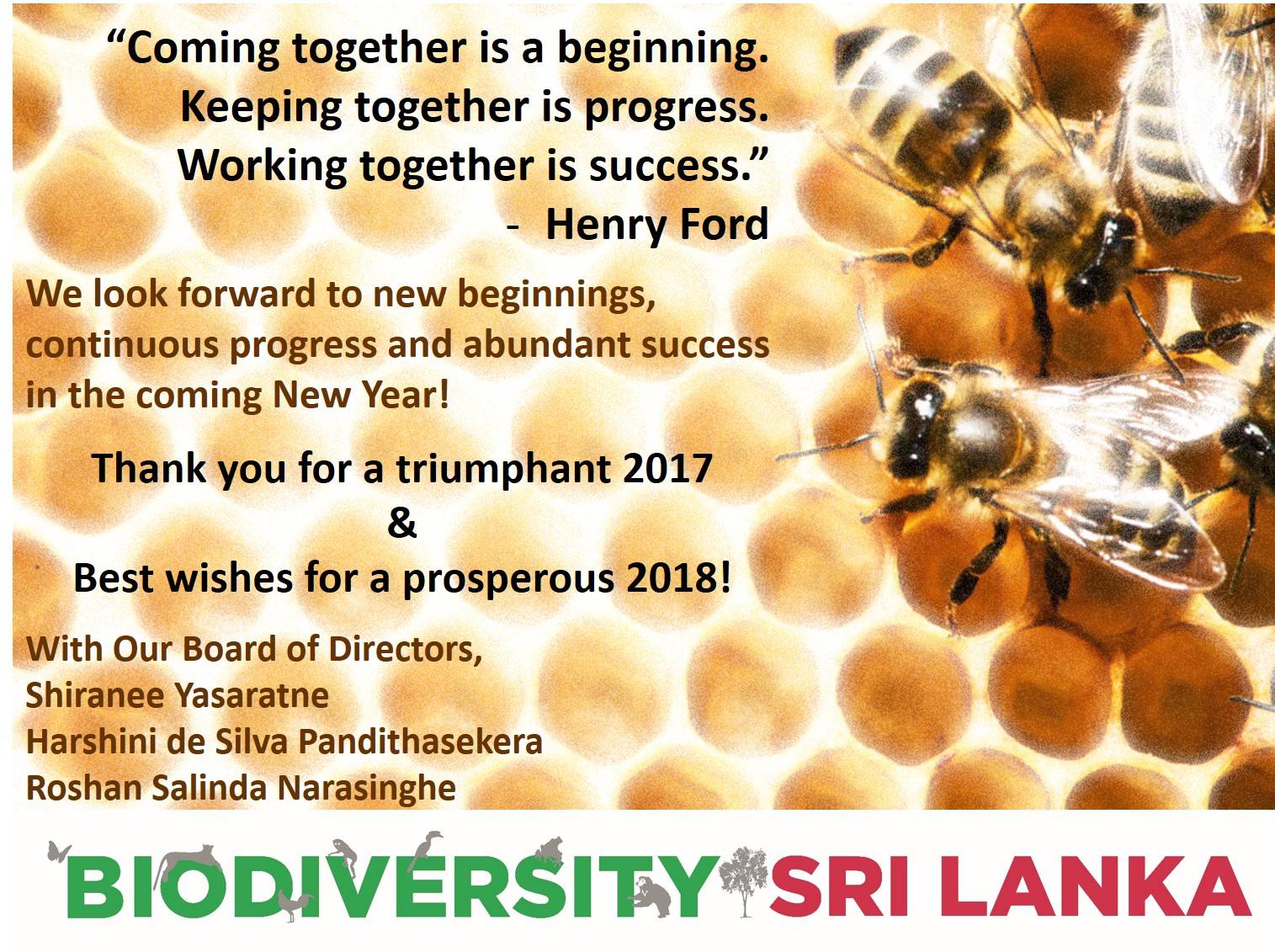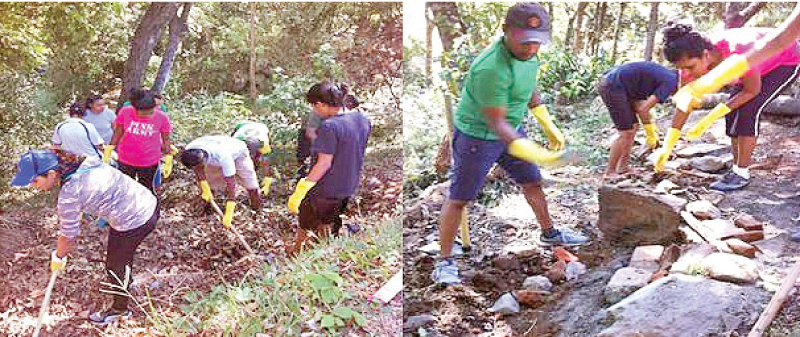
Enhancing environment of Knuckles Conservation Forest
Biodiversity Sri Lanka together with HSBC and IUCN Sri Lanka have been working together on measures to conserve and improve the mini watershed area of the Puwakpitiya Oya in the Knuckles Conservation Forest and Environmental Protection Area.
This engagement has been ongoing since August 2015 and is a three- year intervention. As a responsible corporate entity and a patron member of Biodiversity Sri Lanka, HSBC’s sustainability drives underpin identifying and addressing environmental, social and ethical developments which present risks or opportunities for environment and business. Technical assistance to the project is provided by the International Union for Conservation of Nature, Sri Lanka (IUCN).
The Knuckles Conservation Forest along with the Peak Wilderness Protected Area and the Horton Plains National Park have been declared as an UNESCO World Heritage Site since 2010.
Prior to this, it was declared as a conservation forest by the Forest Department in 2000 and an Environmental Protection Area under the National Environmental Act in 2007. The Knuckles area constitutes 30 percent of the watershed forest of the Mahaweli catchment – a major source of water for the agricultural sector of the country.
Although the forest landscapes in the Knuckles region are managed by the Forest Department and are legally protected, some landscapes are heavily degraded due to anthropogenic activities. Unsustainable land use practices and deterioration of watersheds severely threaten biodiversity and associated ecosystems. The main aim of the project is to restore the ecological value of the Puwakpitiya Oya sub-catchment area in order to enhance watershed functions and biodiversity in order to develop a replicable model to expand the programme to other sub-catchments of this vital forest range.
Puwakpitiya is a highly visited location by local tourists. Hence improving the visitor facilities of the Puwakpitiya (Illukumbura) office of the Forest Department is a part of this project. The HSBC funds have helped the construction of an information centre alongside the development of necessary knowledge products, which will benefit both the Forest Department and the visitors. This centre is expected to be declared open in August 2017.
Although adequate sanitary facilities are a basic need of any household, most of the toilets in the Puwakpitiya area are below standard hygienic levels. Regrettably, a majority of the people within the community do not recognize safe toilet facilities as a basic human need.
The project has improved and promoted the construction of adequate toilet facilities and raised awareness on the importance of sanitation.This is considered to be an eye opener to the villagers and it has been catalytic in getting the villagers to realize associated values. The project is expected to bring about a change at local level, which will have a lasting impact beyond the lifetime of the project.
Since the project area is located within the immediate catchment of the Moragahakanda reservoir, community members are being made aware of crucial conservation aspects through community discussions and meetings. Raising awareness among the community members could finally contribute positively to the conservation of the forest and its buffer zone together with the upper catchment of the Moragahakanda reservoir.
Recently a group of volunteers from HSBC made a field visit to observe and take part in work on ground. This volunteer programme included a visit to the Illukkubura Visitor Centre from June 16-18 where staff actively participated in landscaping and cleaning the centre. They also conducted a visitor awareness programme at Sera Ella.The team actively took part in field interventions and constructed contour barriers on the hilly edges to prevent soil erosion.
Upon completion, the project will have multiple environmental benefits. Firstly, the Knuckles region is well-known for its natural and aesthetic beauty centered on its breathtaking landscapes and associated fauna and flora.
Sustainable utilization of this valuable asset can be achieved through proper conservation and management practices.
Secondly, this region has been declared as one of Sri Lanka’s Natural World Heritage sites namely the Central Highland World Heritage Site because of its unique biodiversity, aesthetic value and ecosystem services. Hence, conservation and management practices will eventually lead to conserving this pristine and valuable ecosystem.
Enhancing watershed services, micro-climate regulation and carbon sequestration would provide both socioeconomic and environmental benefits. A monitoring system will be developed to ensure the sustainability and continuation of the positive outcomes of this project.
Source – – 03/07/2017, Daily News, see more at – http://www.dailynews.lk/2017/07/03/business/120676/enhancing-environment-knuckles-conservation-forest
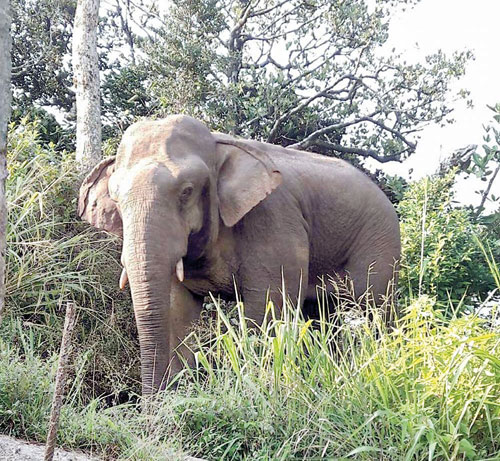
Protect unique Sinharaja with a strict eco-tourism plan
Local and foreign visitors roam this rainforest, home of elephant and leopard, without restriction
By Kumudini Hettiarachchi
A stunning image of a majestic elephant emerging from a mist-laden forest fills the screen…………a little while later along the same pathway tread a group of carefree tourists, both local and foreign. These are the ‘Vistas of Eastern Sinharaja’ and the dangers of not monitoring human visitors to this Protected Area that the Galle Wildlife Conservation Society’s Madura De Silva brought to the audience at an important panel discussion on ‘Biodiversity & Sustainable Tourism’ on May 22 at the HNB Auditorium in Colombo.
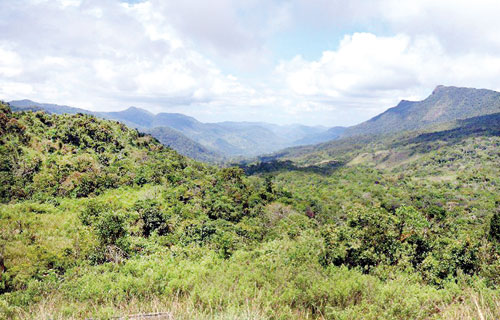
Spectacular and mysterious Sinharaja — a World Heritage Site
The event was organised by Biodiversity Sri Lanka (BSL) on International Day for Biological Diversity with four panellists dealing with ‘Vistas of Sinharaja’; ‘Dollars for Deeds’; ‘Challenges in the Yala National Park (NP)’; and ‘Significance of the coasts around us’. The discussion that followed was moderated by BSL Advisor Shiranee Yasaratne. (Last week, we published ‘Challenges in Yala’ and ‘Significance of coasts’.)
Before Mr. De Silva takes up the major issues that need to be addressed at Sinharaja which falls under the mandate of the Forest Department, he waxes eloquent on this World Heritage Site consisting of tropical sub-montane rainforests and pathana grasslands. Eastern Sinharaja is “unique” due to its geography at an elevation range of 575-1,170m and meteorological patterns of an annual rainfall of between 3,600mm and 5,000mm and annual temperatures ranging from 17-27ºC.
Other factors that make it unique are eight species of point endemic amphibians and four species of lizards. It was at the Morningside Forest Reserve that Mr. De Silva himself and his team also came upon a new species of a point endemic plant, Aponogeton kannangarae.
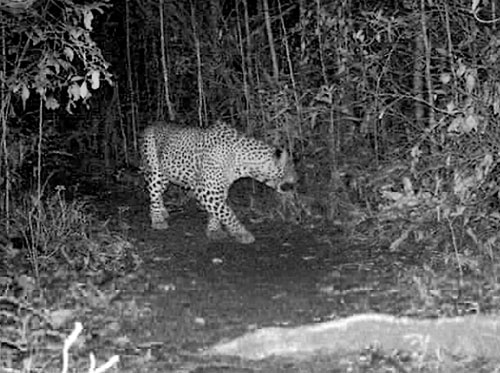
Wet-Zone leopards ‘captured’ by camera traps at Sinharaja in the ongoing research
He elaborates on the Low-land Wet Zone Leopard Project which has as its aim the establishment of a strategic conservation plan for the Big Cats of this area, with the Field Research Centre at Enasalwatta. In this major public-private partnership among the Wildlife Conservation Society of Galle, the Open University of Sri Lanka, the Nations Trust Bank and the Rainforest Ecolodge, Wet Zone leopards are the focus as they are poorly studied, unlike those in the Dry Zone. The studies involve identification of individual leopards by their spots through images from camera-traps, pug-marks and scat analysis. The first-year study results have helped ascertain the leopard distribution in eastern Sinharaja.
Thereafter, Mr. De Silva gives guidelines on how a model for responsible eco-tourism could be established. Urging that there should be an in-depth tour-guide training programme, he says that their knowledge on rainforest ecology and identification of fauna and flora should be improved, while also making them aware of the legal aspects that need to be strictly adhered to under the Fauna and Flora Ordinance when people visit Protected Areas.
“This is while there is a need not only to educate but also make the communities living on the boundaries to participate in the conservation project,” he says, adding that even visitors should be kept in the loop so that they too could provide their expertise and data for the conservation project.
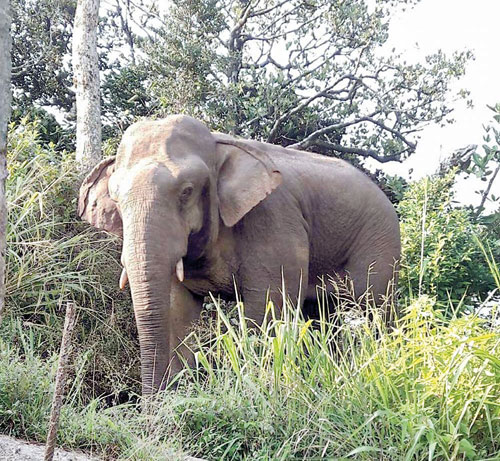
A Sinharaja tusker in all its majesty
| ‘Dollars for Deeds’ conservation programme of Tangalle’s AnantaraIt is Anantara Hotel’s Dilan Bandara from Tangalle who focuses on how they have just embarked on a ‘Dollars for Deeds’ programme for conservation, with the strong support of the International Union for Conservation of Nature (IUCN).
The vision of the programme is for the hotel to match the contribution of guests, $ for $ (dollar for dollar), for conservation. To have solid evidence to show the guests, the hotel has already begun the programme, before seeking guest contributions. Before detailing the programme, Mr. Bandara describes the ‘modern’ traveller as being highly individual, tech-savvy and open-minded. On a mission to live life to the full, he/she seeks the exceptional, thriving in the new, at ease riding horseback on a dusty trail in the Andes as in a spa in the Maldives or enjoying the serendipity of metropolitan encounters in a downtown neighbourhood. “We create journeys of inspiring, surprising moments and enjoyment — elevating all senses and connecting with the environment and culture of each one of our locations. Anantara is a luxury hospitality brand for modern travellers, connecting them to genuine places, people and stories,” he says, stressing that corporate social responsibility (CSR) is a way of life for them. With sustainability development being an integral part of Anantara’s organizational strategy, they are committed to developing ‘The Dollars for Deeds’ programme in Tangalle, he says, laying down their objectives and proposed activities. Conduct in-situ conservation of marine turtles, thus contributing to conserving globally-threatened species. The proposed activities include identifyingthe relevant stakeholders such as hotel staff, government line agencies, and local communities who will be involved in monitoring of turtle-nesting and conducting a workshop on the guidelines that should be followed for recording turtle-nesting.
Tiny turtles waddle towards the sea on the beach of Tangalle Raise awareness on marine turtle conservation and enhancement of field-level capacity of the Department of Wildlife Conservation (DWC) to conduct in-situ conservation of marine turtles. The proposed activities include keeping exhibits — such as eight display panels and models of the five turtle species visiting Sri Lankan shores — at the information corner of the proposed DWC Beat Office in Rekawa and establishing a ‘Media Wall’ at a selected location of the resort to display information/short documentaries on turtles, a section/panel with project related activities to introduce the ‘Dollars for Deeds’ programme. Enhance the representation of native species of flora within the property and establish a typical coastal habitat for native coastal species. Build the capacity of the resort for conservation and sustainability (hotel staff, local communities and guests). The proposed activities include aFund to be utilised for conservation of globally-threatened marine turtles, Asian elephants etc. |
Source – 11/06/2017,The Sunday Times, See more at – http://www.sundaytimes.lk/170611/news/protect-unique-sinharaja-with-a-strict-eco-tourism-plan-244827.html

Yala National Park a mess due to political meddling
Give DWC independence to do its job, urges former DG
Tourism officials conspicuous absentees at biodiversity event
By Kumudini Hettiarachchi
Everyone else was there, except the tourism officials. Even though numerous invites had gone out to a wide-range of tourism officials, no one deemed it important to grace the discussions on ‘Biodiversity & Sustainable Tourism’ vital for people’s existence, held on May 22. This was what the participants at the event organised by Biodiversity Sri Lanka (BSL) on International Day for Biological Diversity held at the HNB auditorium in Colombo heard after queries were raised whether any tourism officials were present.

The panellists (from left) Dilhan Bandara from Tangalle’s Anantara Hotel, Madura de Silva of the Wildlife Conservation Society, Galle, Maeve Nightingale from the International Union for Conservation of Nature (IUCN) and Dr. Sumith Pilapitiya, former Director-General of the Department of Wildlife Conservation.
Four panellists dealt with the crucial topics of ‘Challenges in the Yala National Park (NP)’; ‘Vistas of Sinharaja’; ‘Dollars for deeds’; and ‘Significance of the coasts around us’, after which there was a robust discussion moderated by BSL Advisor Shiranee Yasaratne.
Tackling over-visitation and its consequences on the biodiversity of the Yala NP, former Director-General (DG) of the Department of Wildlife Conservation (DWC), Dr. Sumith Pilapitiya, questioned whether a natural ecosystem can sustain “abuse” in the light of tourist numbers skyrocketing more than 1,000% from 2008 to 2015 – from 48,368 to 545,007 visitors at Yala.
Explaining that no formal studies have been done whether over-visitation has adverse impacts on biodiversity, he pointed out that road-kills have increased within the Yala NP, there is harassment of wildlife at sightings, visitors are feeding wild animals and causing behavioural changes in them and there is anecdotal evidence of a decline in the animal population within Yala.
He was very critical of the government’s “over-emphasis” on tourism revenue, while neglecting protection and management of Protected Areas. Dr. Pilapitiya not only zeroed-in on the problems but also provided answers on how to overcome them. According to him the approach should be the identification of the issues that need to be addressed and the constraints in dealing with them; and studying the profile of tourists using Block 1 of the Yala NP where there are huge issues, while introducing a strategy to improve overall visitor experience there.
“The nature-interpretation services offered by the DWC are poor,” he said, adding that the DWC also faces a dearth of staff and facilities such as patrol vehicles to regulate tourism within the NP. The DWC is challenged by inadequate guide numbers, inability to get government approval for more recruitment, weak enforcement of NP rules and lack of independence to penalize violators.
While there are nearly 700 registered commercial safari vehicles, the issues to be addressed include the indiscipline of safari jeep drivers and passengers whenever there are animal sightings, high speed and reckless driving when attempting to reach such sightings and massive vehicle jams and disturbance of wildlife during sightings.
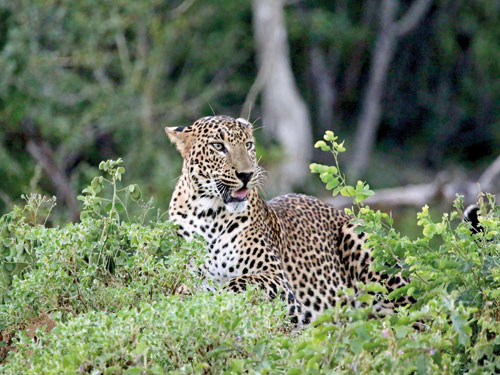
“If there is one paradise for leopards on earth, it has to be Yala National Park,” had said award-winning wildlife photographer Angela Scott but have Yala’s leopards been over-marketed?
The former DWC Director-General who resigned due to political interference preventing him from performing his duties, pointed without ambiguity, at “continued political interference” in the wake of which follows lack of independence for the DWC to regulate tourism within Yala. “There is uneven imposition of rules due to political patronage and interference.”
He also added that while Yala’s Block 1 faced much over-visitation, the wildlife in Blocks 3, 4 and 5 were not habituated to visitor-vehicles. Profiling the current ‘visitors’ to Yala, he said they are focusing on “sightings” and not “observations”, with the NP at present being marketed as a “leopard-sighting location”. Therefore, the short-term strategy for the conversion of Yala into a “wildlife observation site” is impractical.
Dr. Pilapitiya turns the spotlight on an implementable ‘Action Plan’ proposed, which includes:
- 31 short-term actions to be implemented by January 1, 2018 — Regular patrolling, strict enforcement of rules, progressively increasing penalties, speed-bumps, uni-flow system where possible, training of both safari jeep drivers and DWC guides and using Blocks 2, 3, 4 and 5 for ‘wilderness’ tourism.
- 9 medium-term actions to be implemented by January 1, 2019 – Zoning the park, opening the west-side of the Sithulpauwwa Road, a carrying-capacity assessment and halting the over-promotion of Yala by the tourism industry.
- 2 long-term actions by 2023 – With increased sightings in Blocks 3, 4 and 5, imposition of vehicle limits in all blocks through gradual reductions and empowerment of DWC officials.
Dr. Pilapitiya is adamant that DWC officials “must” be empowered to enforce regulations without being fearful of a political backlash. “For this, the responsibility clearly lies with the highest-level political authorities and the Wildlife Minister.”
Referring to the coast around us, it is Maeve Nightingale of the International Union for Conservation of Nature (IUCN) who details marine and coastal tourism that Sri Lanka can engage in, however, stressing that there is a fine balance between conceptual issues and constraints to sustainable tourism, when taking into account the environment (natural habitats and local livelihoods) on one hand and financial criteria (infrastructural development, tourist arrivals and tourism products and services) on the other.
She pointed out that tourism as a whole is the most international “trade” item with reef tourism becoming an increasingly large component. However, the adverse impacts of reef-based tourism could be immense.
Citing the example of the small island of Koh Tao in the Gulf of Thailand, Ms. Nightingale said that it has one of the largest dive industries in the world with over 65 dive schools and operators. It is also accountable for one-third of the annual registrations of the Professional Associations of Dive Instructors (PADI) internationally.
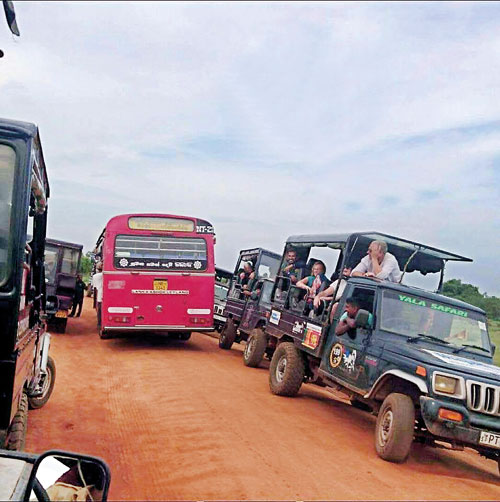
Jam-packed with vehicles – whose home is the Yala National Park?
According to her, Koh Tao’s management issues are wide-ranging – shortage of freshwater and groundwater; inadequate solid waste collection and disposal; untreated wastewater disposal from communities and tourist facilities; rapid unplanned development; construction and encroachment on beach and terrestrial forest; although building legislation and the requirement of environmental impact assessments (EIAs) are in place there is no consistent enforcement; tourist numbers exceeding the island’s carrying capacity; the uneven distribution of benefits from tourism; and the high cost of living for the local people.
The list goes on: High energy demands and dependency on diesel-fuelled generators; localized oil-spills from fishing and tourism boats; coral-reef degradation; decline in fisheries resources; and a development plan launched in 1995 but not well-adopted.
There are key factors to sustainably managing coastal tourism, says Ms. Nightingale. They are:
- Capacity development
- Consideration of a complex range of sub-national, national and transnational relationships
- Regulatory frameworks
- Community involvement, trust, acceptance and support
- Payment for Ecosystem Services (PES) – compensating for loss of earnings, protecting and restoring habitats and conserving endangered species
- Sustainable financing – entrance fees, fund-raising and private sector partnerships
- Coordination among multi-sectoral and multi-faceted agencies
- Collaboration of all stakeholders
Urging Sri Lanka not to go the way Koh Tao has gone, Ms. Nightingale added that many lessons can be learnt from this example.
BSL which organized the event is a private-sector owned and driven platform, with a membership of 63. It has been established to promote the strong engagement of the corporate sector in biodiversity and environmental conservation issues.
Meanwhile, the United Nations Development Programme (UNDP) Sri Lanka and BSL entered into a collaborative partnership, with UNDP as its first Associate Member recently.
Both organizations have identified potential areas of engagement and a set of joint activities, on areas such as policy innovation, social innovation initiatives and engagement of small and medium-sized enterprises
(SMEs). Areas such as environment sustainability and disaster resilience, tourism and biodiversity have been determined where room and potential for collaboration exists, a media release said. (Next: Focus on Sinharaja and how a hotel has turned dollars into deeds)
Source – 4/06/2017, Ther Sunday Times, See more at – http://www.sundaytimes.lk/170604/news/yala-national-park-a-mess-due-to-political-meddling-243493.html

Biodiversity Sri Lanka to commemorate International Day of Biological Diversity
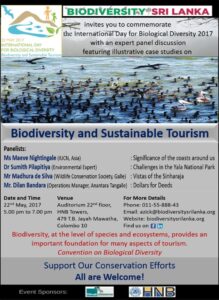 This session will feature four relevant and illustrative case studies from Sri Lanka and the Asia region presented by Maeve Nightingale of IUCN, Asia, environment and wildlife expert, Dr. Sumith Pilapitiya, Madhura de Silva, President, Wildlife Conservation Society, Galle and Ross Sanders, General Manager, Anantara Peace Haven, Tangalle, covering areas such as the significance of the coast around us and carrying capacity and biodiversity issues in our national protected areas.
This session will feature four relevant and illustrative case studies from Sri Lanka and the Asia region presented by Maeve Nightingale of IUCN, Asia, environment and wildlife expert, Dr. Sumith Pilapitiya, Madhura de Silva, President, Wildlife Conservation Society, Galle and Ross Sanders, General Manager, Anantara Peace Haven, Tangalle, covering areas such as the significance of the coast around us and carrying capacity and biodiversity issues in our national protected areas.
The event will be held on the 22nd of May (from 5.00 p.m. to 7.00 p.m.) at the auditorium of the Hatton National Bank, and is open to the general public. Biodiversity, at the level of species and ecosystems, provides an important foundation for many aspects of tourism.
Recognition of the great importance to tourism economies of attractive landscapes and a rich biodiversity underpins the political and economic case for biodiversity conservation.
A well-managed tourism sector can contribute significantly to reducing threats to, and maintain or increase, key wildlife populations and biodiversity values through tourism revenue. Although Sri Lanka is a small island, its biodiversity is significantly important both in a regional and global scale.
The island has been declared as one of the 25 ‘biodiversity hotspots’ of the world. Sri Lanka’s tourism is the country’s third largest foreign exchange earner and contributes a substantial percentage towards the GDP.
In post-war Sri Lanka, tourist arrivals have seen a remarkable increase and there is a significant increase in investments in tourism as well as, infrastructure development through opening up of new tourist attractions.
The theme for this year is primarily about ensuring greater control and management to reduce damage to biodiversity from tourism and pursuing the positive contribution of tourism to biodiversity awareness, protected areas, habitat restoration, community engagement, and resource mobilization.
This theme therefore provides an opportunity to raise awareness and action towards the important contribution of sustainable tourism both to economic growth and to the conservation and sustainable use of biodiversity.
Biodiversity Sri Lanka (BSL) is an entirely private sector owned and driven not-for-profit platform established to promote strong engagement of the corporate sector in biodiversity and environmental conservation issues in Sri Lanka.
BSL actively promotes strong leadership of the private sector in these areas through active learning, providing technical support, sharing information, knowledge and experience, promoting best practices and dialogue with state and civil society partners. Currently, over 65 leading corporates are members of the platform.
Source – 17/05/2017,Dailymirror- See more at: http://www.dailymirror.lk/article/Biodiversity-Sri-Lanka-to-commemorate-International-Day-of-Biological-Diversity-129069.html#sthash.mY12rH8S.dpuf
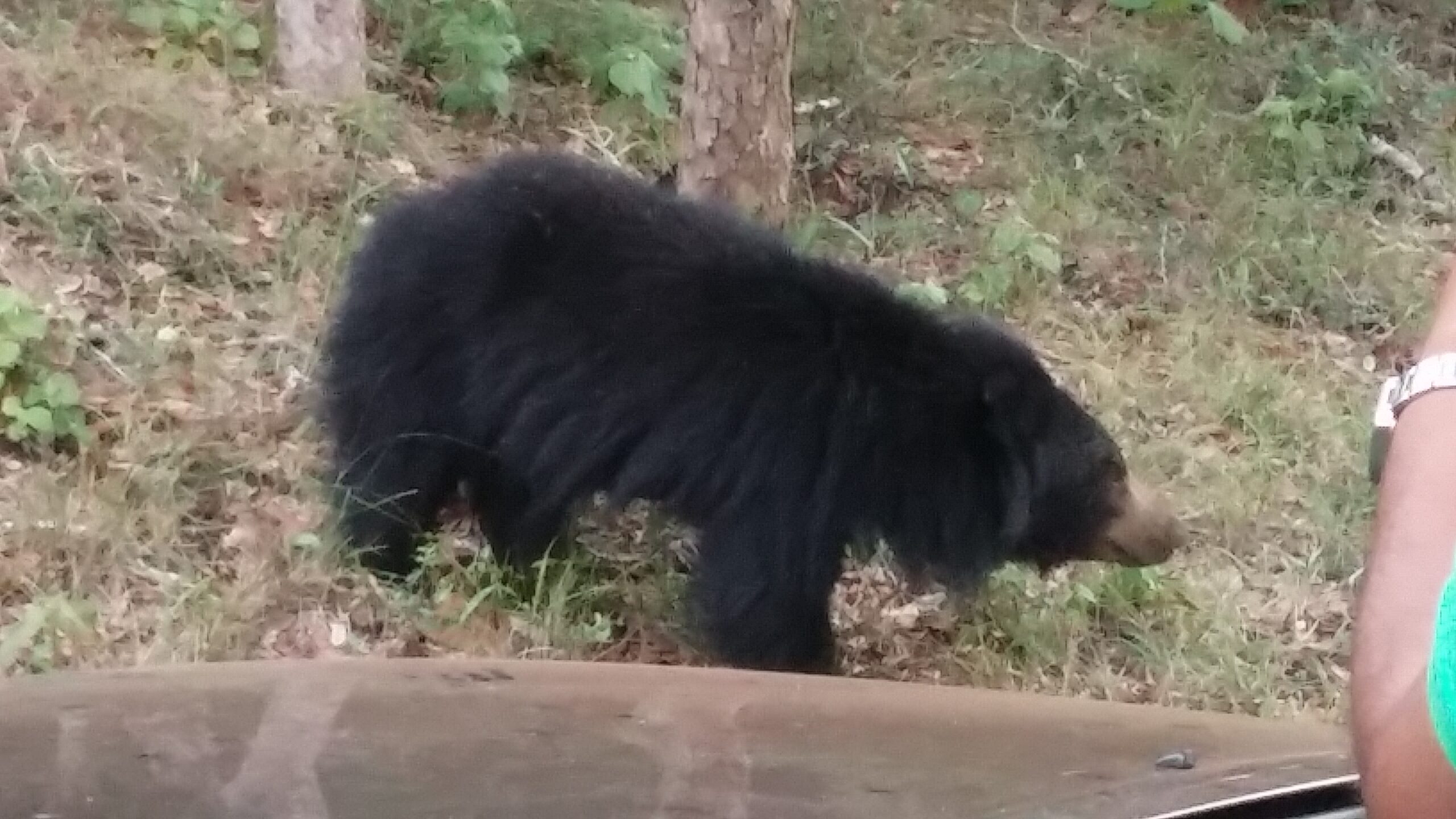
BSL in association with CIC Holdings and BEAR for ESTIMATING THE SLOTH BEAR POPULATION IN WILPATTU NATIONAL PARK
 The Sri Lanka Sloth Bear (Melursus ursinus inornatus) is a subspecies which is endemic to the island nation. The sloth bear is one of the most adversely affected animals due to deforestation and urbanization. As, this species is very sensitive to disturbances, currently it is restricted to the National parks and sanctuaries in the lowlands of the island. Due to prevalent misconceptions among the villagers, the sloth bear has earned the reputation as one of the most dangerous animals in Sri Lanka. It is deliberately avoided by jungle men as the most feared creature in Sri Lanka’s wilds. Even to date, the sloth bears are killed by villagers whenever an opportunity arises, during their forages to the forest to collect honey and other forest products. During the survey several dead sloth bears were found close to villagers, their death was due to gun shots and snares. Sloth bears were reported as abundant during the colonial period, but declined speedily and drastically due to habitat loss and hunting. The colonial sports men used to sit over water holes during the dry season to shoot sloth bears, which come to quench their thirst – sloth bears unlike other large mammals need to have their daily fill of water.
The Sri Lanka Sloth Bear (Melursus ursinus inornatus) is a subspecies which is endemic to the island nation. The sloth bear is one of the most adversely affected animals due to deforestation and urbanization. As, this species is very sensitive to disturbances, currently it is restricted to the National parks and sanctuaries in the lowlands of the island. Due to prevalent misconceptions among the villagers, the sloth bear has earned the reputation as one of the most dangerous animals in Sri Lanka. It is deliberately avoided by jungle men as the most feared creature in Sri Lanka’s wilds. Even to date, the sloth bears are killed by villagers whenever an opportunity arises, during their forages to the forest to collect honey and other forest products. During the survey several dead sloth bears were found close to villagers, their death was due to gun shots and snares. Sloth bears were reported as abundant during the colonial period, but declined speedily and drastically due to habitat loss and hunting. The colonial sports men used to sit over water holes during the dry season to shoot sloth bears, which come to quench their thirst – sloth bears unlike other large mammals need to have their daily fill of water.
In Sri Lanka, population estimates and abundance of the sloth bear is greatly lacking. In order to fill this gap in knowledge and to gather base line data on their population density and home range, the current project was initiated, first in Wilpattu National Park, as it is reported to harbour one of the largest populations of sloth bear, as per a study done in the 1970’s by Eisenberg and Lockhart. This forms the first stage in an island wide study on the Sloth Bear in Sri Lanka.
Our goal is to map, evaluate the population density and composition of sloth bears in Wilpattu National Park and to identify their habitat needs and preferences. The information gained through this study can then be applied island wide in the subsequent strategies and efforts for the conservation of the sloth bear.
The project was initiated on the 3rd of June 2013 with the financial support from CIC Holdings PLC through Biodiversity Sri Lanka. To date over 100 field days have been spent in the wilds of Wilpattu for the said survey and study.

Kalido Beach in Kalutara is facing challenges due to natural erosion combined with growing number of visitors and pollution.
Kalido Beach in Kalutara, is te strip of beach that runs between Kalu Ganga and the Indian Ocean. Although the area is a huge tourist attraction, it is known for its sensitive ecosystem facing challenges such as natural erosion combined with a rapidly growing number of visitors causing damage to the vegetation cover and threats due to pollution.
Biodiversity Sri Lanka visited the area together with the Department of Coast Conservation and Coastal Resources Management to determine possible areas of intervention to minimize adverse effects to this valuable ecosystem.
We were saddened to see irresponsible destruction to the thick cover of beach front Pandanus (Watakeiya) by local visitors. Indiscriminate dumping of garbage was seen everywhere. This ecosystem has acted as a barrier to the tsunami of 2004.
If the value of these rich natural resources are not understood by the communities that use them, we are bound to face more threats and undue challenges into the future.

